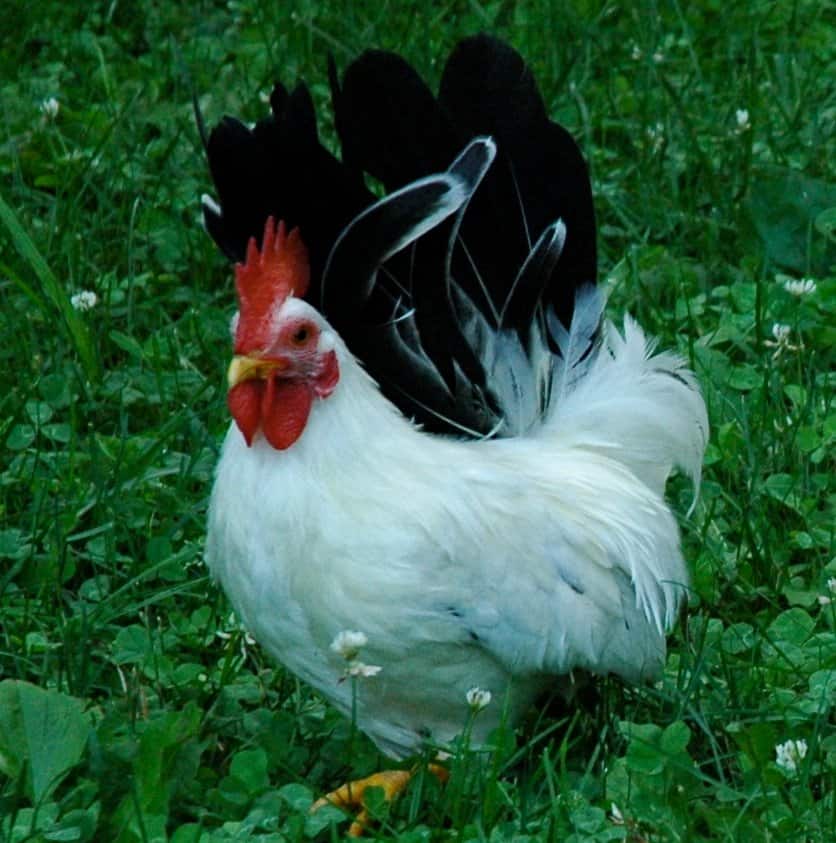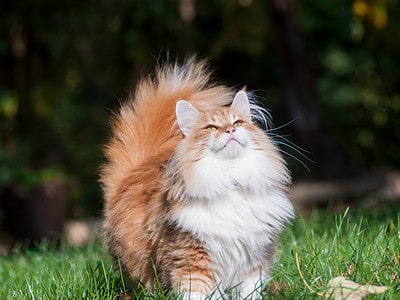Japanese bantam chickens are the best flying chicken species
Advertisement
Japanese Bantam Chicken Scientific Classification
- Kingdom
- Animalia
- Phylum
- Chordata
- Class
- Aves
- Order
- Galliformes
- Family
- Phasianidae
- Genus
- Gallus
- Scientific Name
- Gallus gallus domesticus
Read our Complete Guide to Classification of Animals.
Japanese Bantam Chicken Conservation Status
Japanese Bantam Chicken Locations

Japanese Bantam Chicken Facts
- Prey
- Worms, insects
- Name Of Young
- Chicks
- Group Behavior
- Flock
- Fun Fact
- Japanese bantam chickens are the best flying chicken species
- Biggest Threat
- Cold weather, predators
- Most Distinctive Feature
- Short legs
- Distinctive Feature
- Tail feather goes over it's head
- Gestation Period
- 20-30 days
- Incubation Period
- 20-30 days
- Age Of Independence
- 2 months
- Predators
- coyotes, foxes, bobcats, weasels and their relatives, birds of prey like hawks and eagles, raccoons, possums, skunks, bears, rodents, snakes, stray dogs, and wild cats
- Diet
- Omnivore
- Lifestyle
- Diurnal
- Flock
- Social
- Favorite Food
- Worms, chicken feed
- Origin
- Japan
- Location
- Worldwide
- Group
- Flock
- Nesting Location
- In chicken coup hutches
View all of the Japanese Bantam Chicken images!
Summary
The Japanese bantam chicken is a breed of ornamental chicken or Gallus gallus. Commonly known as Chabo, this chicken breed was only found in Japan and a few other South and East Asian countries until 1868, when the government reopened to foreign trade, and the bird was imported to Europe and the USA. They have distinctive short legs and lay smaller eggs than standard domesticated chickens. They are considered to be the best flyers out of all chickens!
5 Incredible Japanese Bantam Chicken Facts
- Japanese bantam chickens are one of the few domesticated breeds of chicken considered true bantam chickens.
- They are very small, nearly one-third the size of standard chicken breeds!
- They are the best flyers out of all domestic chicken breeds. They not only fly well, but you had better keep an eye on them in the open because they love to fly away!
- Japanese bantam chicken’s tail feathers are taller than their head.
- Due to their unique physique and color diversity, they are often bred as show or pet birds.
Where is the Japanese Bantam Chicken Found?
Originating in Japan, they are now found in every continent with the exception of Antarctica.
Japanese Bantam Chicken Scientific Name
The Japanese bantam chicken’s scientific name is Gallus gallus domesticus. This breed of domestic chicken is considered a “true bantam breed,” meaning that their average size and eggs are naturally smaller than those of a typical domestic chicken. This breed of chicken is over 500 years old. Derived from the shamo fighter chicken breed via selective breeding, they were known as creepers and originated in South China.
Japanese Bantam Chicken Appearance

Japanese bantam chickens are easy to tame and make great pets!
©Putneypics / Creative Commons – License
The Japanese bantam chicken is a small, compact bird with tiny legs and a long tail that extends above its head. It is one of the few domesticated breeds that’s considered a “true bantam.” This means it is never bred to the standard chicken size (about 30 inches, 6 lbs) but is always much smaller (8-10 inches, 1-3 lbs).
Their coloring depends on which region the bird is in, but they vary significantly. For example, in New Zealand they only come in white or black, but in China or Vietnam, you may find them in grey, lavender, or even orange colors.
Japanese Bantam Chicken Behavior
The Japanese bantam chicken is often a very easy-to-tame breed. In fact, most chickens of this breed are kept as pets rather than as poultry. While the roosters are as aggressive as standard-size chickens, the hens are quiet and social. All domestic chicken breeds, including this breed, are diurnal, meaning they sleep during the night and are active during the day.
Japanese Bantam Chicken Diet
Japanese bantam chickens are an omnivorous breed, i.e., they eat plants such as seeds and grain and insects, mainly worms and insects. Occasionally, they eat small lizards and even mice! However, their primary food is chicken feed consisting of various grains.
Chicks are often fed a chick starter. After 8 weeks of age, a balanced diet of chicken pellets, grains, chicken mash, or grain mix first thing in the morning is often sufficient. They also love to scavenge for worms and insects for a quick snack.
Japanese Bantam Chicken Habitat
The Japanese bantam chicken can thrive in any geographic location as long as it has access to food, warmth, and shelter. While you can find them in almost every country, the breed is not robust in cold weather. Therefore, they are rare in especially cold regions. They require a warm coop for proper protection from the cold during the winter months. They also require adequate space to maintain proper health of at least 10 square feet per chicken. In contrast, a standard-sized chicken only needs 3-5 square feet to maintain a healthy life.
This breed of chicken is not found naturally in the wild, as they were cross-bred in east Asia to be domestic animals.
Japanese Bantam Chicken Predators and Threats
Due to their small stature, they are vulnerable to harsh temperatures and predators.
Some common predators are coyotes, foxes, bobcats, weasels, birds of prey, possums, snakes, stray dogs, cats, and bears.
The other main threat is harsh weather. High winds and low temperatures can cause the birds to freeze.
Japanese Bantam Chicken Reproduction
The Japanese bantam chicken has mating rituals similar to other chickens. The rooster dances with his erect tail around the hen and entices her before mounting. A rooster often mates 10-30 times a day depending on how many hens are around. It takes 7 to 10 days after mating for a hen to lay fertilized eggs.
Once the fertilized eggs are laid, the gestation period is anywhere from 20 to 30 days. This incubation time often depends on the environmental conditions of the chicken. After the incubation period, the eggs hatch, and chicks are born.
They lay only around 75 eggs per year, much fewer eggs than the average chicken. In addition, 25% of the eggs will die before hatching due to a lethal Creeper gene that causes stunted skeletons. The Creeper gene causes these chickens to have short legs and be smaller in general. Another 50% of the eggs laid per year will hatch normally and the chicks will have short legs, and the remaining 25% will inherit the normal chicken gene and have longer legs. This gene is unique in Japanese bantam chickens.
Japanese bantam chicks use a baby tooth, called an egg tooth, to chip away at the shell when they are ready to hatch. This tooth is temporary and will drop off after the chick is out of the egg. They are called chicks until three months of age. They hatch from their tiny eggs and stay with their mother for the first eight weeks after hatching and become self-sufficient at around two months of age. While Japanese bantam chicks can often see right after birth, they generally don’t start walking until they are 8-24 hours old.
Japanese Bantam Chicken Lifespan
While an average domestic chicken can live between 6-10 years, in spite of not being a very hardy bird, these chickens can live almost twice that! The female of the breed can live between 13-16 years, while a male can live between 10-13 years. Roosters have a shorter lifespan due to their aggressive and territorial behavior.
One disease that affects them is called the pip (infectious coryza). The risk of the pip starts at 14 weeks and continues throughout the chicken’s life. Another disease common in these chickens is gapes (syngamus trachea) a fatal condition caused by the presence of worms in the chicken’s windpipe.
Japanese Bantam Chicken Population
Japanese bantam chickens are a very trendy ornamental chicken breed. There are countless breed societies, and every year, they are featured at hundreds of shows.
Japan and Europe boasts the highest population. Japan bred them around 300 years ago and then distributed them for the first time in Europe after Japan’s opening to the world in 1868.
There is no official estimate of how many there are worldwide. But, as these chickens are high-maintenance and do not reproduce as rapidly as other breeds, their population is not greatly increasing.
Similar Animals
View all 36 animals that start with JJapanese Bantam Chicken FAQs (Frequently Asked Questions)
Are Japanese bantam chickens carnivores, herbivores, or omnivores?
Japanese bantam chickens are omnivores. Their diet includes poultry pellets, seeds, selected fruits and vegetables, and some bugs.
Why are the Japanese bantam chicken’s legs so short?
Japanese bantam chickens have very short legs because of a gene (called the creeper gene) that causes skeletal shortening.
Which bantam chicken is the most popular?
There are almost 400 different varieties of bantam chickens. The rosecomb bantams and the silkie bantams are the most popular.
What is the lifespan of Japanese bantam chickens?
Japanese bantam chickens can live between 13-15 years, almost twice that of a typical chicken.
How many eggs does a Japanese bantam lay every year?
In one year, the Japanese bantam lays an average of 50 to 75 eggs.
Can Japanese bantam chickens fly?
Japanese bantams can fly quite well, unlike most normal chickens. They generally require higher fences for their coops than standard chickens.
Are Japanese bantam chickens high-maintenance?
The Japanese bantam chickens are higher maintenance birds than other chicken breeds. This is due to their physical characteristics and their vulnerability to the cold and predators.
Thank you for reading! Have some feedback for us? Contact the AZ Animals editorial team.
Sources
- Kim Irvine, Available here: https://domesticanimalbreeds.com/japanese-bantam-chicken-breed-everything-you-need-to-know/
- Cackle Hatchery, Available here: https://www.cacklehatchery.com/?s=japanese+bantam+chicken&post_type=product
- Chicken Scratch, Available here: https://cs-tf.com/bantam-chicken/

















